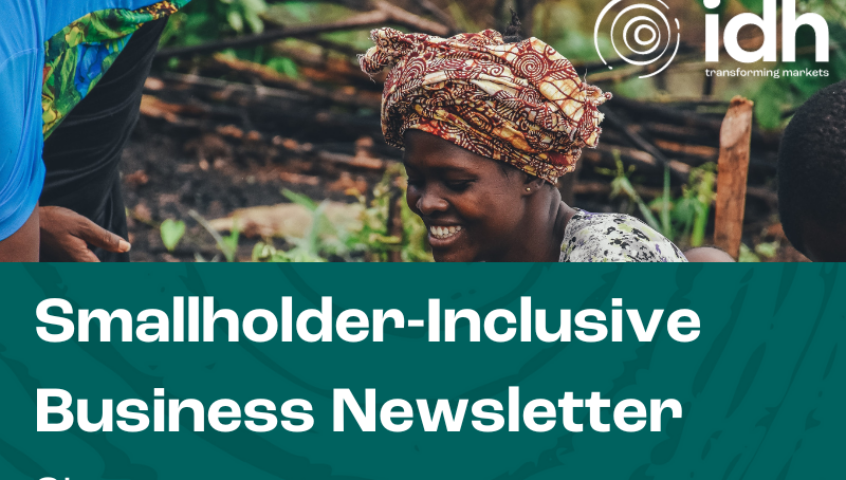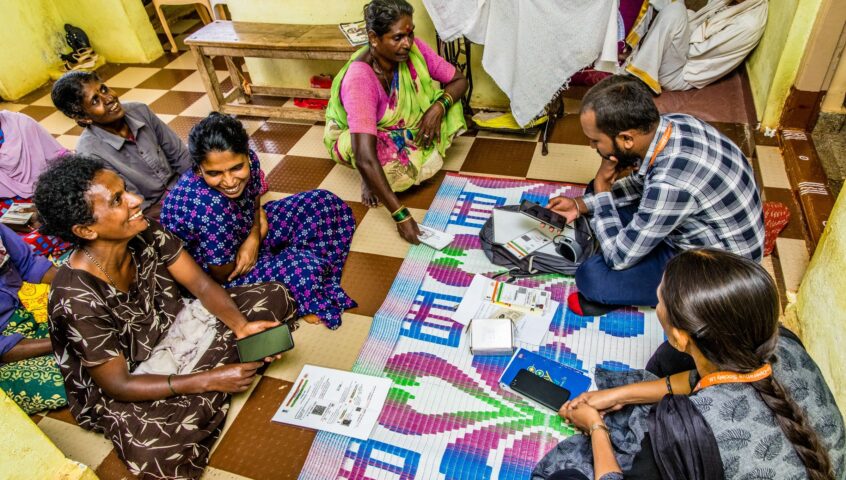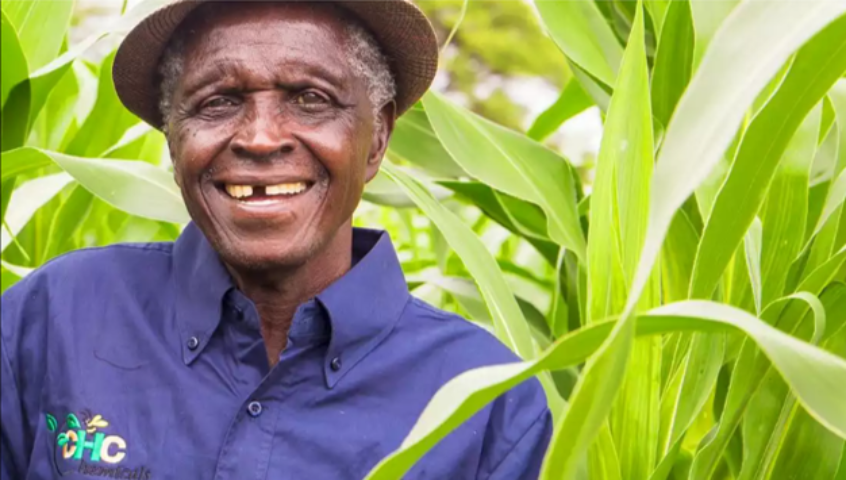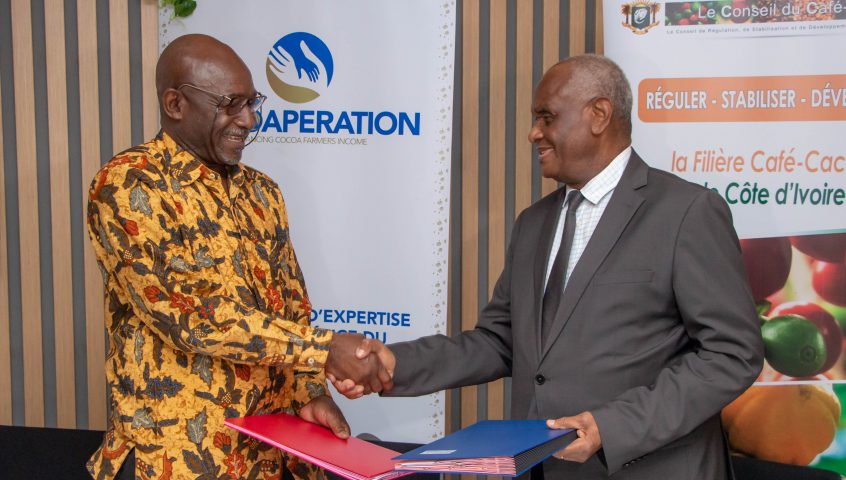6 June 2024 – Blog by Thomas Kockmeyer – Impact and Learning Advisor, IDH Investment Management
Getting to know Koa – Juice, not beans
The Ghanaian-Swiss start-up, Koa, is the first company in West Africa to unlock a new value chain around the overlooked cocoa pulp. Koa was set up to significantly raise farmer income and empower rural communities in West Africa through food innovation. The company creates an additional revenue stream for farmers that is independent of cocoa beans, decoupling from the inherent price volatility and many of the other sectors or market’s imperfections. Working directly on-farm with small-scale cocoa producers, Koa utilizes parts of the cocoa fruit that are usually discarded (pulp and husk) and generally overlooked by the cocoa industry. Using cocoa pulp, Koa creates innovative and sustainable ingredients for the chocolate, confectionery, ice cream, and beverage industry. Cocoa pulp is naturally delicious and does not require any additives. Koa turns the pulp into juice, dried pulp powders, as well as juice concentrates, which can be used in gastronomy and the food industry.
Some well-known brands or examples of products that make use of Koa’s ingredients include Kumasi Drinks (widely available in Dutch supermarkets) as well as Lindt & Sprüngli’s COCOA PURE chocolate bar, made 100% from cocoa fruit.
Building Partnership towards a resilient cocoa value chain
Koa’s innovative business model and its potential to realize farmer income impact were key motivators for the Landscape Resilience Fund (LRF) and IDH Farmfit Fund to provide a term loan to the company, totaling USD 3.5 million back in 2022. This 5-year loan is dedicated to the establishment of Koa’s second processing plant, including machinery and equipment. The new processing plant enables Koa to increase its production capacity, generating additional income opportunities for up to 10,000 cocoa farmers.
We were looking for mission-aligned investors with a smallholder focus. What was particularly interesting about IDH and IDH Farmfit Fund was its knowledge about the cocoa industry. This makes IDH special among our investors. Unlike many other impact investors, IDH Farmfit Fund is also open to supporting a company that works with farmers who are not certified. As we work with the most rural, disadvantaged farmers, certification is a requirement that our farmers would not be able to meet at this point.

Fabien Nizard
Head of Corporate Finance & Investor Relations, Koa
Towards the end of 2023, Koa closed a USD 15 million series B equity round including an investment of Land Degradation Neutrality (LDN) Fund. In 2024, IDH, which manages TA facilities for both LDN and IDH Farmfit Fund, launches a joint two-year TA program to train farmers on Good Agricultural Practices and regenerative agriculture with a clear business case for farmers. A model farm will be established serving as a hub for the program and for demonstration and training purposes for farmers in the region. In addition, a pilot will be launched for approximately 20 farmers to test, monitor and measure potential impact on cocoa yield and soil health.

On-farm innovation with direct payments at a critical time
Koa sources cocoa fruit by integrating modern technology into a traditional environment, and utilizes solar-powered Community Mobile Processing Units (CMPUs). The specially developed technology allows the processing and cooling of cocoa fruit products on remote cocoa farms and in the centre of communities. Farmers harvest their beans, including pulp, and Koa accompanies them to the CMPU, offering free transportation. The CMPU separates pulp from the beans. Farmers retain the beans which they continue to ferment, dry, and sell as they are used to. They receive the payment for the pulp in their mobile wallets on the same day. This payment comes at a critical time when farmers are most cash-strapped. The payment for the sale of cocoa beans comes only weeks or months later, after drying and export of the beans. The juice income allows farmers to cover immediate expenses, such as hired labour to harvest their crop or cover other livelihood expenses, such as schoolbooks or uniforms for their children. All of Koa’s payments to farmers are tracked via blockchain and can be followed on Koa’s website, ensuring not only traceability but full transparency[1].
Africa’s largest cocoa fruit factory opens its doors
Koa was founded in 2017, starting out with one small processing plant. Six years later, in August 2023, the company celebrated an important milestone, the opening of its second factory located in Akim Achiase in the Eastern Region of Ghana. Much larger than the first factory, the processing plant in Achiase will allow Koa to operate at industrial scale.

IDH Farmfit Fund (the Fund), together with South Pole’s Landscape Resilience Fund (LRF), provided long-term CAPEX loans to Koa for the construction of the new factory in 2022. The initial commitment of the Fund and LRF helped Koa secure the equity financing they needed. Instead of the initially targeted EUR 3M in equity, Koa raised EUR 4M in their Series A round. After the Fund’s and LRF’s joint investment, other investors such as Land Degradation Neutrality (LDN) Fund and responsAbility have come on board to provide equity or working capital, supporting the operationalization of the factory.
IDH Farmfit Fund as a debt provider has enabled us to raise equity from institutional investors a lot easier and with a lot more credibility.

Fabien Nizard
Head of Corporate Finance & Investor Relations, Koa
The construction of the factory was not without challenges. Heavy rainfall outside of the rainy season made the construction process more difficult. Global challenges, such as record-high inflation and currency depreciation – a 50% drop of the Ghana Cedi against the US dollar in October 2022 – further affected the construction, raising prices for labour, housing, electricity, fuel and hence transport costs.
My vision for the factory was to create a state-of-the-art cocoa pulp processing factory. With this being the first decentralised cocoa fruit factory in the world, we needed to pioneer the process. Over the years, the project plan evolved several times. The concept and design, however, stayed the same.

Daniel Otu
Koa’s Production and Operations Director & the factory project lead
On August 25th, 2023, the factory was inaugurated in the presence of 600 guests among whom were farmers, customers, community members, and government representatives, such as the Ghanaian Minister of Trade and Industry, Hon. Kobina Tahir Hammond.
The new factory will allow Koa to scale its business and meet the demand for cocoa fruit products. It will generate 250 new jobs in rural Ghana. Additionally, the plant will extend Koa’s cocoa fruit sourcing to an additional 10,000 farmers, of which 40% are targeted to be women and 20% youth (18-35 years), providing them with a supplementary income source.
[1] https://koa-impact.com/radical-transparency/
Koa places the integration of social and environmental sustainability at the centre of its business model. An interview with Fabien Nizard, Koa’s Head of Corporate Finance & Investor Relations, provides further insight on Koa’s purpose, the company’s interaction with smallholder farmers, the new factory, and the experience of fundraising for the company’s growth strategy.
Many of us are aware of the challenges in the cocoa industry. How do Koa and cocoa fruit juice fit into this picture?
At the core of the business idea lies the will to connect a profitable venture with social and environmental purpose with a balanced Triple Bottom Line approach: People, Planet, Profits. On the social side, Koa focuses on farmer poverty and how Koa can contribute to closing the Living Income Gap for cocoa farmers in West Africa. We fully realise that we will not be able to close it ourselves completely. Koa only focuses on the by-products, as 75% of the crop is typically not utilized – neither by the farmer nor by the industry.
Our objective is to valorise the entire fruit. This creates a win-win for all stakeholders, tackling the income gap for farmers, while at the same time benefitting the environment by minimizing food waste, and reducing the carbon footprint.
What vision does Koa work towards?
We set ourselves ambitious targets with the intention not to be a niche solution for a few farm communities. We work on transforming and improving, rather than disrupting, the cocoa industry for the 800,000 cocoa farmers in Ghana. Koa envisions being the leading brand that turns valuable plant-based resources into meaningful joy and socio-ecological impact in rural West Africa.
The intention was never to only look at Ghana, but we had to start somewhere. A rational next step would be an expansion to Côte d’Ivoire where there are an estimated 1.2 million cocoa farmers.

Koa’s Vision:
To be the most reliable fruit processing brand that innovatively turns valuable plant-based resources into meaningful joy and socio-ecological impact in rural West Africa.
We’re doing something completely new, so there’s no one more experienced who could have told us how to do it.
What do you do differently from a traditional cocoa player?
By design, we are not afraid to get close and cooperate directly with smallholder farmers. Traditional cocoa players often rely on intermediaries, such as purchasing clerks, cooperatives, Limited Buying Companies, etc., to source cocoa beans in 64kg bags. What is unique about Koa is that we work hand in hand with the producers directly on their farms to make the logistics for the cocoa pulp work. This often makes us the only stakeholder that is present on the ground in the rural areas.
What support do you offer farmers on the ground?
We recognise that the smallholder service landscape is limited. Cocoa traders or LBCs offer some training, but it is not regular enough and does not cover all farmers. COCOBOD cannot itself deal with all 800,000 farmers. We started out training farmers on the new process required by Koa as we need to ensure hygiene on the farm with clean buckets, hair nets, face masks etc.. Doing this we realized that our farmers had a gap in knowledge on Good Agricultural Practices (GAP). Ultimately, we created a separate service department that complements our existing sourcing team, where they work hand in hand to offer GAP training.
Apart from training, we are doing different things to improve farmers’ climate resilience. For instance, we support farmers to comply with the COCOBOD’s recommendation of 18-20 shade trees per hectare. In addition, we are training farmers on composting to improve fertility and soil moisture retention. Finally, we are piloting biochar soil application, mixing fertilizer, compost, and biochar from cocoa husk to give back to farmers.
Could you share some insights on farmer income? Are there already some initial results from the farmer survey you just completed?
By working with Koa, farmers earn an extra income from the pulp. For the season 2023/2024, this is an extra income of up to GHS 3,500 (approx. USD 280) for each ton of dried cocoa beans they harvest.
The more cocoa pulp we source from an individual farmer, the more additional income they get. However, due to logistical and production constraints, we cannot source 100% of their pulp and there are many more farmers out there who want to work with Koa. So naturally there is a trade-off that we want to balance between maximising income benefit for each farmer and how many farmers can benefit.
Our recent farmer household baseline survey shows that 60% of farmers rely on cocoa as their main income source and cocoa represents two-thirds of their overall household income.
As a result of working with Koa, l make additional income from the sale of cocoa juice which I have used to undertake various activities. The earnings have enabled me to renovate part of my house and I am able to help support my children’s school fees, our electricity bills and our hospital bills. I have even been able to purchase a plot of land on which I am planning to raise a new building. Before joining Koa, I used to carry out all the farm activities by myself. Now I am able to hire four people and sometimes more to help me undertake my activities at the farm.

Sarah Afful
Sarah Afful, cocoa farmer from Assin Ayigbo in Ghana. She has been in cocoa farming for 11 years and worked with Koa for 4 years. She manages 6 acres of farmland (2.4ha).
How has your fundraising journey been like, leading up to the construction of the factory?
We are taking a wide approach to fundraising, targeting many types of audiences and investors. Historically, we had the most success in raising equity from family offices and private individuals, specifically those with a prior link to the food industry and a desire to create an impact through their investment activities.
The timing of the Fund’s investment, together with the Landscape Resilience Fund (LRF), was important to build the second factory and close the Series A round, which was linked to obtaining debt financing. The Fund’s and LRF’s letters of intent were critical to close the equity round, showing the equity investors that there was an appetite of lenders to finance the factory. Having the Fund’s and LRF’s commitment allowed us to solve this ‘chicken and egg’ situation. In the end, we were able to raise EUR 4 million in equity, instead of the EUR 3 million we targeted.
There is also a link between the IDH Farmfit Fund and LRF’s joint investment to the recent equity we raised from the Land Degradation Neutrality (LDN) Fund. The Environmental and Social Management System (ESMS) in accordance with IFC Performance Standards that we developed with the Fund and LRF to manage E&S risks helped us a lot to bring LDN Fund on board and pass their Due Diligence.
What is next for Koa in 2024 and beyond?
Growth will be the main objective. We look back at a challenging year with a bad cocoa harvest for the entire industry. With our new factory up and running, we are looking to start the year focusing on healthy growth, aiming to bring supply and demand for cocoa juice products closer together. That means bringing the factory to full capacity as well as making cocoa fruit juice a more well-known ingredient and product across consumer markets.







